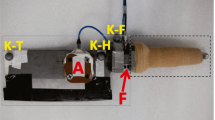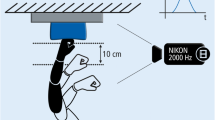Abstract
We examined the possibility of inflicting serious injuries with sharp objects in an experimental setting by throwing four sharp objects from different distances and with different throwing techniques. Using an overarm-handle (OA/H), overarm-blade (OA/B), underarm-handle (UA/H), underarm-blade (UA/B) and thrust (T/H) throwing technique, 10 adults (sex ratio 1:1) threw a chef’s knife, a skinning knife, a paring knife and office scissors from 4 m and 2 m distance at synthetic abdomen models made of 10% gelatin covered with synthetic skin. The amount of hits and penetrations of the target and their penetration depth were noted, as was the rotation of the blade tip towards the target along its flight trajectory. The chef’s knife injury/hit ratio was 0.167/4 m and 0.160/2 m; the skinning knife recorded an injury/hit ratio of 0.087/4 m and 0.153/2 m; the paring knife of 0.087/4 m and 0.113/2 m; and the scissors 0.087/4 m and 0.067/2 m. Mean penetration depths were as follows: the chef’s knife: 4 m, 4.42 cm, 2 m, 3.41 cm; the skinning knife: 4 m, 4.19 cm, 2 m, 4.11 cm; the paring knife: 4 m, 1.62 cm, 2 m, 1.55 cm; and the scissors: 4 m, 2.08 cm, 2 m, 0.95 cm. Handle-throw penetration-depths were: 4 m: 3.77 cm and 2 m: 2.86 cm; blade-throw depths were: 4 m: 3.14 cm and 2 m: 2.69 cm. Overarm-throw penetration-depths were: 4 m: 3.62 cm and 2 m: 3.25 cm; and underarm-throw penetration-depths were 4 m: 3.30 cm and 2 m: 2.30 cm. No thrust-throws with the paring knife and scissors could pierce the target. The tips pointed toward the target at angles of 60°-120°, earlier in handle-throws than blade-throws, especially with the paring knife and the scissors. When thrown, especially with a handle-held technique, heavier objects pierced more often and more deeply. Thrust-throws at short distances are unlikely to pierce a human.


Similar content being viewed by others
References
Parmar K, Hainsworth SV, Rutty GN. Quantification of forces required for stabbing with screwdrivers and other blunter instruments. Int J Legal Med. 2012;126:43–53.
O'Callaghan PT, Jones MD, James DS, Leadbeatter S, Holt CA, Nokes LD. Dynamics of stab wounds: force required for penetration of various cadaveric human tissues. Forensic Sci Int. 1999;104:173–8.
Kaatsch HK, Mehrens C, Nietert M. Der reproduzierbare Messerstich. Rechtsmedizin. 1993;3:67–76.
Jones S, Nokes L, Leadbetter S. The mechanics of stab wounding. Forensic Sci Int. 1994;67:59–63.
Bolliger SA, Kneubuehl BP, Thali MJ, Eggert S, Siegenthaler L. Stabbing energy and force required for pocket-knives to pierce ribs. Forensic Sci Med Pathol. 2016;12:394–8.
Nolan G, Hainsworth SV, Rutty GN. Forces required for a knife to penetrate a variety of clothing types. J Forensic Sci. 2013;58:372–9.
Wilke N, Püschel K. Bumping into a knife--exculpatory statement or (tragic) accident? Arch Kriminol. 2011;228:108–13.
Sterzik V, Kneubuehl B, Rupp W, Bohnert M. Stab or throw? Biomechanical studies on the injuring potential of glass fragments. Forensic Sci Int. 2010;199:e1–4.
Sterzik V, Kneubuehl BP, Ropohl D, Bohnert M. Injuring potential of drinking glasses. Forensic Sci Int. 2008;179:e19–23.
O'Callaghan PT, Jones MD, James DS, Leadbeatter S, Evans SL, Nokes LD. A biomechanical reconstruction of a wound caused by a glass shard--a case report. Forensic Sci Int. 2001;117:221–31.
Muggenthaler H, Drobnik S, Hubig M, Niederegger S, Mall G. Experimental throws with a knife to clarify a case of domestic violence. Arch Kriminol. 2013;231:46–54.
Kneubuehl BP. Simulants. In: Kneubuehl BP, Coupland RM, Rothschild MA, Thali MJ, editors. Wound ballistics. Basics and applications. 1st ed. Berlin, Heidelberg, New York: Springer; 2011. p. 136–56.
Fackler ML, Malinowski JA. The wound profile: a visual method for quantifying gunshot wound components. J Trauma. 1985;25:522–9.
Gawlick H, Knappworst J. Zielballistische Untersuchungsmethoden an Jagdbüchsengeschossen. In: Ballistisches Laboratorium für Munition der Dynamit Nobel AG. Werk: Stadeln; 1975.
Ragsdale BD, Josselson A. Predicting temporary cavity size from radial fissure measurements in ordnance gelatin. J Trauma. 1988;28:S5–9.
Bolliger SA, Thali MJ, Bolliger MJ, Kneubuehl BP. Gunshot energy transfer profile in ballistic gelatine, determined with computed tomography using the total crack length method. Int J Legal Med. 2010;124:613–6.
Thali MJ, Kneubuehl BP, Zollinger U, Dirnhofer R. The "skin-skull-brain model": a new instrument for the study of gunshot effects. Forensic Sci Int. 2002;125:178–89.
Thali MJ, Kneubuehl BP, Zollinger U, Dirnhofer RA. Study of the morphology of gunshot entrance wounds, in connection with their dynamic creation, utilizing the "skin-skull-brain model". Forensic Sci Int. 2002;125:190–4.
Thali MJ, Kneubuehl BP, Dirnhofer RA. "Skin-skull-brain model" for the biomechanical reconstruction of blunt forces to the human head. Forensic Sci Int. 2002;125:195–200.
Acknowledgements
The authors would like to thank the late Emma Louise Kessler, MD, whose legacy supported this study financially. We are also indebted to Ariane Kluge, Corina Braem, Philipp Hinderberger, MD, Franziska Kluschke, MD, Daniel Kuhn, Michaela Lanfranchi and Daniela Rehberg, for their time and patience as throwing participants, to Sebastian A. Poschmann for assistance in gelatin casting and to Adrian M. Bolliger, PhD, for critical review of the manuscript.
Author information
Authors and Affiliations
Corresponding author
Rights and permissions
About this article
Cite this article
Schaerli, S., Schulz, R., Gascho, D. et al. Injury potential of thrown sharp kitchen and household utensils. Forensic Sci Med Pathol 14, 31–41 (2018). https://doi.org/10.1007/s12024-017-9937-7
Accepted:
Published:
Issue Date:
DOI: https://doi.org/10.1007/s12024-017-9937-7




